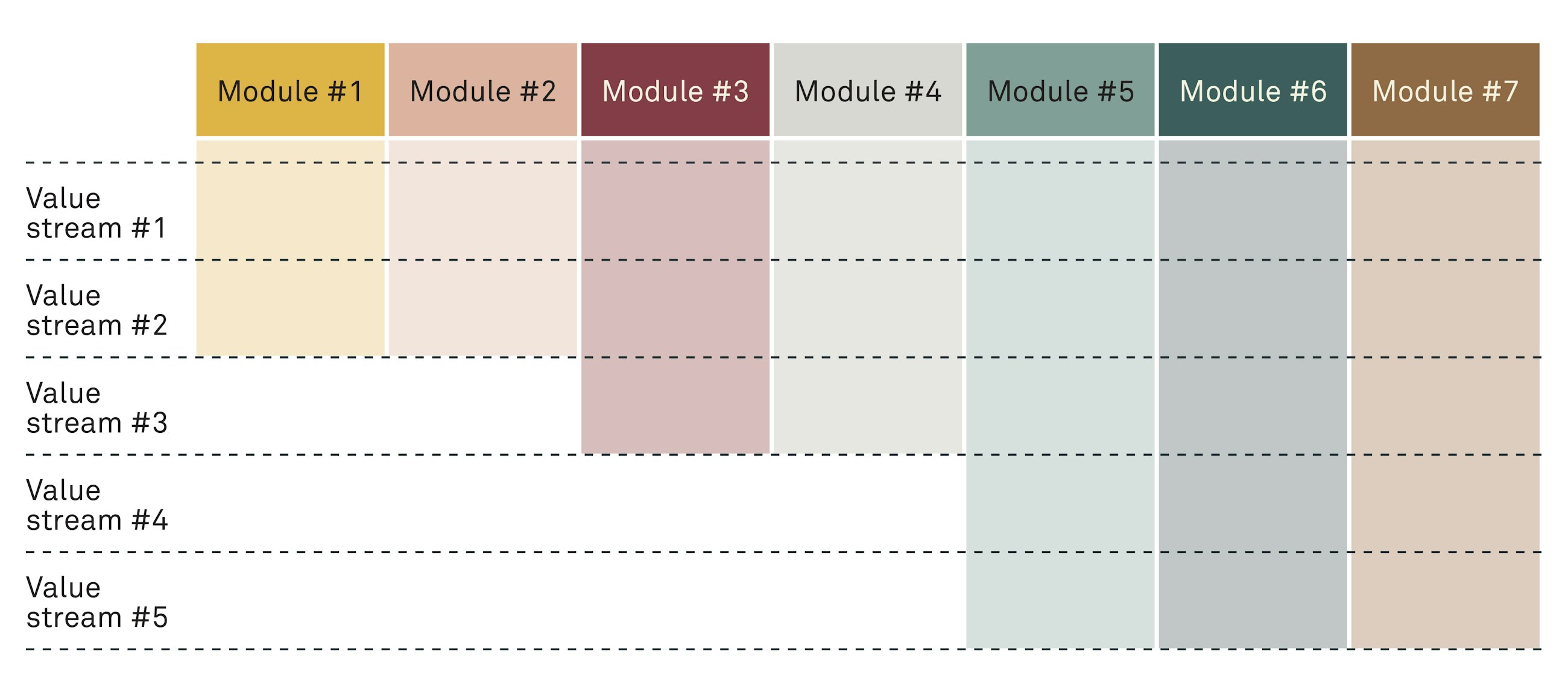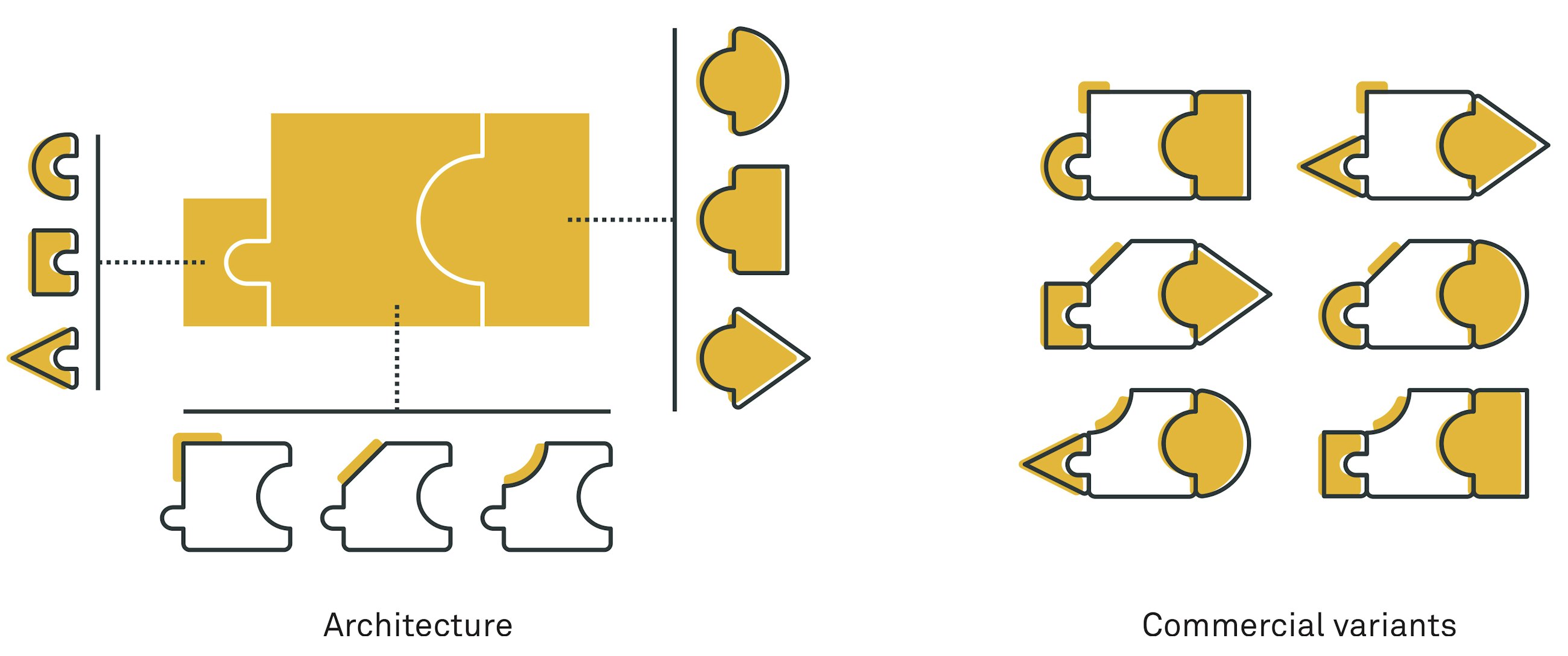- and harvest the full potential of being agile
1 October 2020
Agile seems to be floating into any organisation that wants to increase efficiency and speed of their development activities. However, a lot of these companies start to experience an uncontrolled growth of complexity, less time for real innovation and declining benefits of scale. Therefore, we do see companies starting to apply the principles of modular product design to their organisational setup to boost the effects of being truly agile.
For sure, agile is top of mind in most companies that want to beat competitors by increasing efficiency and speed of their development activities while simultaneously aiming for faster, better and cheaper offerings to their customers. Therefore, we see a lot of companies initiating large-scale transformation programmes that influence the entire organisation and turn them into agile superheroes.
New challenges arise when organisations go agile
Companies that have already embarked on the agile transformation journey certainly start harvesting great business benefits such as improved quality, increased focus on business and customer value, transparency and predictability, larger stakeholder and employee engagement etc. However, these companies also start identifying new challenges that need to be managed.
The challenges that arise when the companies go agile are challenges such as:
- How do you succeed in managing an agile organisation that works more autonomously without igniting an uncontrolled growth of internal product-related complexity?
- How do you make time for innovative product ideas to come through when an ever-accelerating need for speed in NPD projects is present?
- How do you sustain customer centricity and serve the individual needs in a rushing market that calls for myriads of new product variants and still safeguard the benefits of scale?
Agile methods and principles do, to some extent, have the answer, i.e. on questions such as how to manage small and independent teams, how to approach creative thinking and iterative prototyping systematically and how to keep adapting to customers’ changing priorities. However, we tend to forget to focus on the actual products and the product portfolio itself – and more importantly, the way products are designed and developed over time.
An unaddressed need
Consequently, we see an unaddressed need to define clear processes for how we develop future modular products, explicit structures describing the product platform and visionary strategies to manage the actual product design and evolvement of the product portfolio going forward.
If we do not define clear processes, we risk reinventing the wheel when designing and developing products from scratch, imposing non-value-adding activities, longer time to market, increased cost and unhappy customers, which is the ultimate toxin for any company.
To fight these challenges, we do see companies applying the principles of modular product design to their organisational setup. They may also apply the principles to their operating model within new product development (NPD) to help combat the uncontrolled growth of complexity, allow for innovation and safeguard the benefits of scale. Moreover, we see that adding modular product design to the organisation boosts the effects of being truly agile.
However, we cannot just apply the principles of modular product design to our organisational setup. We need to make a change in the organisational structure, the current processes and tools and not least the present culture and mindset among the employees. To put it simple, we need to adjust our agile organisational setup to foster a modular way of working.
What is modular product design?
Modular product design and modularity are well-known disciplines in many large-scale engineering companies. Basically, they describe the company’s asset in terms of product architecture, modules and variants. The product architecture describes the structure and preferred way of building products and describes the standard units (the platform), the individual submodules in the product as well as the key interfaces. Modularity is a term describing the act of reducing the number of internal components in the product architecture while at the same time allowing the ability to increase commercial variants to the customers.
Introducing module teams to your agile organisation to fight complexity
Typically, agile organisations are structured around value streams in specific application areas that continuously create value to the customers by executing a certain amount of development initiatives limited by the available capacity.
The individual teams work independently and with a customer-centric mindset and often with short deadlines to push the development forward. Therefore, the teams often reduce the time used to obtain knowledge about best practices based on internal experience and knowledge (about e.g. design principles, choice of material, manufacturing processes etc.) to a minimum.
Frequently, development teams start with the latest version of a product variant as their baseline and then start to modify that to fit the new customer needs. In principle, this can be fine, but imagine what happens if you scale the development effort to the next level (e.g. expansion of a small company or scaling a large global corporation) and you have a bunch of individual development teams defining their own baseline and starting to develop from scratch. That is where complexity starts to accelerate and sneak into your organisation.
Example
An example from a manufacturing company in the energy sector
Take a large manufacturing company in the energy sector as an example. They once experienced that they had great success with delivering products with the right performance and features to their customer, however; lead times were increasing, margins were dropping, and product complexity was exploding.
The company investigated the root cause and figured out that their value streams did “one-off” designs without building upon best practices or latest versions. In other words, when the developers and engineers started on new assignments, they took their own personal projects (and darlings) and started adjusting the features and performance to fit the new customer requirements. Over time, the company had lost control of the situation and as a result had several value streams spending time on developing approximately the same product feature but with minor and insignificant differences that even customers would not recognise. Without nobody realising it, the company ended up with an enormous product complexity that was difficult to manage and maintain, which slowed down the entire organisation.
If you want to avoid product-related complexity exploding in your organisation, the solution is to establish module teams across your value streams. The module teams work as knowledge and development hubs and are responsible for capturing generic needs across all value streams and safeguarding module fit to current and future product launches. Also, the module team must guide the value streams in strategic choices and selection of submodule variants and module components and in addition provide a risk assessment of choosing one variant over another.
By having module teams serving the value streams, you are more unlikely to experience unnecessary development taking place, and you can keep the product-related complexity at a manageable level.
Make “reuse” your new best friend to allow time for innovation in your NPD projects
For many developers (e.g. engineers), the unknown and undiscovered things are the most exciting to engage with. They seek to be innovative and develop the next new cool and innovative solution. However, this may lead to development of non-valuable solutions that are too superior or even gold-plated – solutions that customers do not want to pay for.
You may experience that the development organisation reacts negatively when you introduce them to modular product design. A typical reaction is that they believe that it will limit their ability to think out of the box and slow down development activities by limiting their work with rigid product architectures and rules for reuse that they must obey to launch future commercial variants. But in fact, when you introduce modular product design and clear architectures, it is the other way around.
By introducing the principles of modular product design, your organisation gains clear insights into architectural consequences of changing specific units/interfaces and the opportunity to reuse well-proven and existing solutions that have been developed for the time being. This allows the developers to narrow down their development efforts to what matters most for the customer while simultaneously knowing the effects of the changes in the product. Thereby, they can focus all their innovative energy on the very specific parts of the product that require the coolest and most innovative thinking to stay relevant in the marketplace.
When you increase the amount of reuse, you also reduce the overall risk in the development project and elevate the accuracy (the right product at the right price in the right place) of future product launches and commercial variants in the market. So, when you reuse existing knowledge and well-known solutions, you will accelerate the overall time to market significantly and unleash additional time for innovation activities simultaneously.
Long-term benefits of modular ways of working:
- Increased growth through development of new products and expansion of the portfolio (increased variety) by intensified time spent on value-adding innovative design activities.
- Accelerated time to market and increased flexibility to respond to changes in user demands due to a modularised setup.
- Reduced total cost and complexity in product portfolio and operations due to a constrained number of components and increased reuse.
- Improved predictability on product launches and budget combined with mitigation of risks due to reuse of well-known solutions.
Guard the customer-centric mindset in your organisation but insist on the benefits of scale
Naturally, customer centricity is central to many agile organisations, and it is indeed an important mindset to foster – also after introducing modular product design to your organisation. However, it is essential that you manage the good intensions from sales representatives offering all kinds of possible (and impossible) solutions to the customers and the developers, who (only) want to develop new solutions from scratch without limitations.
You must guide sales representative to stay within the modular platform, and they must be explicitly aware of the consequences if they do not. Luckily, this can be handled in a configuration system varying from a simple Excel sheet to a dedicated IT system. Also, you must guide the developers to ensure use of standards by design guidelines and architectural insights into the product design. When you guide clearly towards what is best for the customer and the company, it is possible to serve customers in the long run and safeguard benefits of scale.
Of course, your organisation must be able to serve individual customer needs. However, it should be handled in an intelligent way by having a modular product architecture that only allows variance when it adds real value to the customer. In addition, you must also compare the variance that your organisation decides to offer your customers to the drawbacks of reduced benefits of scale, e.g. prolonged time needed for development activities, heavy investment and change of manufacturing facilities etc. All in all, it is very much about getting the balance right.
Introducing modular product design principles to your organisation will help you secure the necessary variance of product offerings to the different markets and customers. At the same time, it will also help you safeguard uniformity on internal processes and structures for the actual design and evolvement of the product portfolio, which all secure benefits of scale.
Product platforms and modularisation help organisations combat the uncontrolled growth of complexity, allow innovation and safeguard the benefits of scale.
But introducing product platforms and modularisation is a year-long activity that requires full commitment from the entire organisation and calls for top management support. When you have that in place, your organisation can change to a modular way of working and overcome the new challenges of being an agile superhero.







